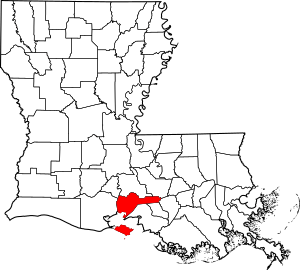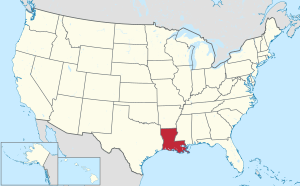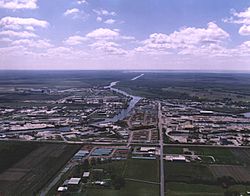Iberia Parish, Louisiana facts for kids
Quick facts for kids
Iberia Parish
|
|
|---|---|
|
Parish
|
|

Historic House and Garden Shadows-on-the-Teche
|
|

Location within the U.S. state of Louisiana
|
|
 Louisiana's location within the U.S. |
|
| Country | |
| State | |
| Founded | October 30, 1868 |
| Named for | Iberian Peninsula |
| Seat | New Iberia |
| Largest city | New Iberia |
| Area | |
| • Total | 1,031 sq mi (2,670 km2) |
| • Land | 574 sq mi (1,490 km2) |
| • Water | 456 sq mi (1,180 km2) 44% |
| Population
(2020)
|
|
| • Total | 69,929 |
| • Density | 67.83/sq mi (26.188/km2) |
| Time zone | UTC−6 (Central) |
| • Summer (DST) | UTC−5 (CDT) |
| Congressional district | 3rd |
Iberia Parish (French: Paroisse de l'Ibérie, Spanish: Parroquia de Iberia) is a parish located in the U.S. state of Louisiana. At the 2020 census, it had a population of 69,929; the parish seat is New Iberia.
The parish was formed in 1868 during the Reconstruction era and named for the Iberian Peninsula. It is part of the 22-parish Acadiana region of the state, with a large Francophone population. Some of its ethnic French residents had ancestors who settled here after being expelled in the 18th century by the British from Acadia in present-day Canada. Historically, it has also been a center for sugar cane cultivation and produces the most sugar of any parish in the state.
Iberia Parish is part of the Lafayette metropolitan area. The Port of Iberia has a waterway with access to the Gulf Coast.
Contents
History
Iberia Parish was created from parts of St. Martin Parish and St. Mary Parish in 1868. It was part of an effort by the Reconstruction-era government to create parishes in which there would be large Republican-majority populations, composed primarily of freedmen in those years.
This territory was part of the sugar parishes, where sugar cane plantations were developed along the waterways before and after the Civil War, dependent on labor of high numbers of enslaved African Americans before the war. Sugar cane was a lucrative commodity crop for planters. Relations between whites and blacks were troubled after the Civil War, as whites sought to dominate freedmen, by violence and intimidation if necessary.
The period after the Reconstruction era was one of increasing violence, especially at the turn of the century and into the early 20th century.
In the late 19th century, there was often a labor shortage on the sugar plantations. Planters recruited thousands of Italian immigrants as temporary laborers, many Sicilians who had first settled in New Orleans. They were needed during the fall harvest and processing season, which extended from October to January. The Italians became part of the volatility of social relations, struggling to make their way between planters and negro workers, and competing with other workers for jobs.
The parish economy changed markedly in the 20th century after the discovery of oil. The Port of Iberia was developed into an industrial center. New types of jobs became available for African Americans. Iberia produces the most sugar of any parish in the state.
Geography
According to the U.S. Census Bureau, the parish has a total area of 1,031 square miles (2,670 km2), of which 574 square miles (1,490 km2) is land and 456 square miles (1,180 km2) (44%) is water. This includes Marsh Island.
Major highways
 Future Interstate 49
Future Interstate 49 U.S. Highway 90
U.S. Highway 90 Louisiana Highway 14
Louisiana Highway 14 Louisiana Highway 31
Louisiana Highway 31 Louisiana Highway 83
Louisiana Highway 83 Louisiana Highway 85
Louisiana Highway 85 Louisiana Highway 86
Louisiana Highway 86 Louisiana Highway 87
Louisiana Highway 87 Louisiana Highway 182
Louisiana Highway 182
Adjacent parishes
- St. Martin Parish (north, south)
- Iberville Parish (northeast)
- Assumption Parish (east)
- St. Mary Parish (southeast)
- Vermilion Parish (west)
- Lafayette Parish (northwest)
Protected areas
The parish has both national and state protected areas within its borders.
National protected area
- Shell Keys National Wildlife Refuge
State protected areas
Part of the Attakapas Wildlife Management Area is located within Iberia Parish, as well as in St. Mary and St. Martin parishes.
Communities
Cities

- Jeanerette
- New Iberia (parish seat and largest municipality)
Town
- Delcambre (part)
Village
Census-designated place
Unincorporated communities
- Avery Island
- Bob Acres
- Emma
- Olivier
- Rynella
Demographics
| Historical population | |||
|---|---|---|---|
| Census | Pop. | %± | |
| 1870 | 9,042 | — | |
| 1880 | 16,676 | 84.4% | |
| 1890 | 20,997 | 25.9% | |
| 1900 | 29,015 | 38.2% | |
| 1910 | 31,262 | 7.7% | |
| 1920 | 26,855 | −14.1% | |
| 1930 | 28,192 | 5.0% | |
| 1940 | 37,183 | 31.9% | |
| 1950 | 40,059 | 7.7% | |
| 1960 | 51,657 | 29.0% | |
| 1970 | 57,397 | 11.1% | |
| 1980 | 63,752 | 11.1% | |
| 1990 | 68,297 | 7.1% | |
| 2000 | 73,266 | 7.3% | |
| 2010 | 73,240 | 0.0% | |
| 2020 | 69,929 | −4.5% | |
| U.S. Decennial Census 1790-1960 1900-1990 1990-2000 2010-2013 |
|||
| Race | Number | Percentage |
|---|---|---|
| White (non-Hispanic) | 38,572 | 55.16% |
| Black or African American (non-Hispanic) | 22,984 | 32.87% |
| Native American | 247 | 0.35% |
| Asian | 1,933 | 2.76% |
| Pacific Islander | 3 | 0.0% |
| Other/Mixed | 2,293 | 3.28% |
| Hispanic or Latino | 3,897 | 5.57% |
As of the 2020 United States census, there were 69,929 people, 26,185 households, and 20,409 families residing in the parish. The 2019 American Community Survey estimated 69,830 people lived in Iberia Parish. Approximately 25.6% of the population were under 18 years of age and 51.1% of the population was female. At the census of 2000, there were 73,266 people, 25,381 households, and 19,162 families residing in the parish. The population density was 127 people per square mile (49 people/km2). There were 27,844 housing units at an average density of 48 per square mile (19/km2).
In 2000, there were 25,381 households, out of which 39.50% had children under the age of 18 living with them, 53.20% were married couples living together, 17.20% had a female householder with no husband present, and 24.50% were non-families. 21.10% of all households were made up of individuals, and 8.70% had someone living alone who was 65 years of age or older. The average household size was 2.82 and the average family size was 3.28.
In the parish the population was spread out, with 30.00% under the age of 18, 9.60% from 18 to 24, 28.40% from 25 to 44, 20.60% from 45 to 64, and 11.40% who were 65 years of age or older. The median age was 33 years. For every 100 females there were 92.80 males. For every 100 females age 18 and over, there were 89.80 males in 2000.
In 2019, the parish had a median income $48,861 and mean income of $23,290. An estimated 21.9% of the parish population lived at or below the poverty line. The median income for a household in the parish was $31,204, and the median income for a family was $36,017 in 2000. Males had a median income of $32,399 versus $18,174 for females. The per capita income for the parish was $14,145. About 20.20% of families and 23.60% of the population were below the poverty line, including 31.50% of those under age 18 and 20.20% of those age 65 or over.
At the 2000 census, the racial makeup of the parish was 65.08% White, 30.81% Black or African American, 0.31% Native American, 1.93% Asian, 0.02% Pacific Islander, 0.60% from other races, and 1.25% from two or more races. About 1.50% of the population were Hispanic or Latino of any race. Of the population, 11.99% reported speaking French or Cajun French at home, while 1.48% speak Lao and 1.29% Spanish. The 2019 census estimated determined 58.6% of the population was non-Hispanic white, 32.8% Black or African American, 0.6% American Indian or Alaska Native, 2.7% Asian, 0.1% Pacific Islander, 1.9% multiracial, and 4.3% Hispanic or Latin American of any race.
Education
Iberia Parish School System serves the parish.
Iberia parish also has several private schools. These include Catholic High New Iberia (of the Roman Catholic Diocese of Lafayette in Louisiana), Acadiana Christian School and Highland Baptist School.
Iberia Parish is in the service area of Fletcher Technical Community College and of South Louisiana Community College.
National Guard
E Company 199th Forward Support Battalion is stationed in Jeanerette, Louisiana, and B Company 2-156th is stationed in New Iberia, Louisiana. Both units have deployed twice to Iraq, 2004-5 and 2010, as part of the 256TH IBCT.
See also
 In Spanish: Parroquia de Iberia para niños
In Spanish: Parroquia de Iberia para niños

